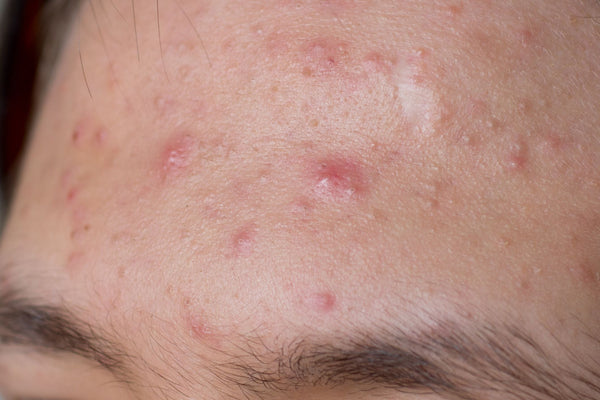
Jump to:
Struggling with stubborn, itchy bumps that refuse to go away, even after using your go-to acne products? You might be dealing with fungal acne.
According to dermatologists, this condition is caused by an overgrowth of a yeast called Malassezia, which leads to a condition known as Malassezia folliculitis, commonly referred to as fungal acne.
Unlike acne, which is triggered by bacteria and clogged pores, fungal acne requires a different approach. Since it’s a yeast-related condition, regular acne treatments don’t work and may even make things worse.
To effectively treat fungal acne, dermatologists recommend using antifungal agents that target yeast and inhibit its growth.
In this guide, we’ll dive into the causes of fungal acne, identify common symptoms, and highlight the most effective treatments available. I’ll also introduce dermatologist-approved ingredients and share practical tips to help prevent future flare-ups.
What Causes Fungal Acne?

Normally, your body keeps the yeast overgrowth in check, maintaining a healthy balance between bacteria and fungi on your skin. However, when this balance is disrupted, yeast can multiply rapidly. This overgrowth can infect your hair follicles, leading to the itchy, pimple-like bumps that characterize fungal acne.
Several factors can trigger this imbalance:
-
Heat and humidity: Warm, moist environments create the perfect conditions for yeast to thrive. This is why fungal acne is more common in tropical climates during hot, sweaty summers.
-
Sweat and trapped moisture: Sitting around in sweaty clothes after a workout or rewearing unwashed gym gear can create a breeding ground for yeast. Tight, non-breathable clothing can also trap heat and moisture, making things worse.
-
Overuse of antibiotics: Long-term use of antibiotics (either topical or oral) can wipe out the good bacteria that keep yeast in check, allowing the fungi to take over and cause inflammation.
-
Compromised immune system: People with weakened immune systems are more prone to developing fungal acne because their bodies may struggle to maintain the balance of bacteria and fungi on the skin.
-
Diet high in sugar and carbs: Yeast loves feeding on sugar and carbohydrates. A diet rich in these foods can contribute to yeast overgrowth, potentially making fungal acne worse.
Common Symptoms of Fungal Acne
 Fungal acne tends to have distinct characteristics that make it easier to differentiate from regular acne. Here’s a quick list of the most common symptoms:
Fungal acne tends to have distinct characteristics that make it easier to differentiate from regular acne. Here’s a quick list of the most common symptoms:
-
Small, uniform bumps: Red or skin-colored bumps that appear uniform in size. Often cluster together and may feel itchy.
-
Location on the body: Typically found on the forehead, chest, back, and shoulders. Less common in areas like the jawline or cheeks, where regular acne occurs.
-
Itching or burning sensation: Accompanied by itching or a mild burning sensation. Symptoms may worsen after sweating or in hot, humid environments.
-
Persistent breakouts despite traditional acne treatments: Breakouts that don’t improve or get worse with standard acne treatments like benzoyl peroxide, salicylic acid, or antibiotics.
How to Diagnose Fungal Acne

Diagnosing fungal acne can be tricky because it looks similar to regular acne but doesn’t respond to typical acne treatments. If you’re experiencing persistent, itchy bumps that worsen after sweating or in humid conditions, it’s essential to consult a dermatologist immediately.
A dermatologist can accurately diagnose fungal acne through a visual exam or by performing tests. In addition to prescription creams, dermatologists may sometimes prescribe an oral antifungal treatment that can work faster than topical creams.
How to Treat Fungal Acne at Home?

While mild cases of fungal acne can often be managed with home treatments, it’s important to seek professional evaluation if symptoms persist or worsen. Ignoring the condition or using the wrong treatments may lead to prolonged discomfort and recurring breakouts.
With that in mind, here’s how to manage fungal acne at home:
-
Shower Immediately After Sweating
If you work out regularly or sweat a lot, showering and changing clothes right after can help wash away sweat and yeast buildup. Lingering moisture in sweaty clothes creates the perfect environment for yeast to thrive, so don’t hang around in gym clothes for too long.
If you’re looking for a men's body wash with a fungicide, ULOS Skin Wash Foaming contains cymene-5-ol (an antimicrobial and antifungal agent) and a dipotassium glycyrrhizate (an anti-inflammatory ingredient), which both help to remove odor and prevent acne.
-
Use Breathable Fabrics
Tight, non-breathable clothing traps heat and moisture, encouraging yeast overgrowth. Opt for loose, breathable fabrics like cotton to improve air flow and prevent sweat from accumulating.
You may also consider using a 100% cotton bath towel like Imabari Towel, known for its softness, absorbency, and fast-drying properties. Its gentle, hypoallergenic fabric helps reduce bacteria, minimize irritation, and maintain clearer skin.
-
Use Anti-Dandruff Shampoo as a Face and Body Wash
According to a dermatologist, Dr. Jenny Liu, MD, FAAD, Dandruff shampoos can double as a face and body wash to treat mild fungal acne. Anti-dandruff shampoos that contain active ingredients with antifungal properties, such as zinc pyrithione, selenium sulfide, and ketoconazole, are most effective at treating fungal acne.
Head & Shoulders is an easily available option recommended by Dr Liu. Apply the shampoo to the affected areas, let it sit for 5 minutes, and then rinse thoroughly. Use it a few times a week during a breakout and once a week afterward to keep things under control.
-
Apply Antifungal Creams
Over-the-counter (OTC) antifungal treatments, like creams or ointments for athlete’s foot or jock itch, can also help. Look for products with ketoconazole, butenafine, or clotrimazole. Apply the cream to affected areas twice daily until the breakout clears up.
-
Exfoliate to Reduce Excess Oil and Dead Skin
Regularly exfoliating can help clear away dead skin cells, excess oil, and dirt that contribute to yeast growth. Use a gentle exfoliator, especially after sweating, to minimize the risk of clogged pores and fungal overgrowth.
If you're looking for an effective yet gentle exfoliator, Japan’s best-selling Cure Natural Aqua Gel might be your perfect solution. Just gently massage it, and the gel will transform into a milky liquid, bringing up dead skin residues. AHA Cleansing Research Body Peel Soap is another top-rated option for removing dead skin cells. It features plant-derived ingredients that provide gentle yet effective exfoliation.
-
Use Salicylic Acid or Antiseptic Wipes Post-Workout
If showering immediately after a workout isn’t possible, wipe down with body wipes. This can help reduce sweat and oil buildup until you can properly cleanse your skin.
Sea Breeze Deodorant Cooling Body Wipes are a great option as they contain ingredients that disinfect and remove bacteria from the skin and menthol, which provides a cooling and refreshing sensation to soothe post-workout skin.
-
Avoid Oil-Based Skincare Products
Yeast thrives in oily environments, so skip oil-based moisturizers and opt for lightweight, oil-free alternatives. This helps maintain hydration without feeding the yeast. Opt for gel cleansers, as these skincare products are usually water-based and formulated to be oil-free.
-
Apply Diluted Tea Tree Oil as a Spot Treatment
Tea tree oil has natural antifungal properties. Dilute 1-2 drops with 12 drops of a carrier oil (like jojoba or squalane) and apply it to affected areas. Since some people have sensitive skin, it’s best to patch-test before applying it more widely.
If you’re looking for a medicated toner as part of your skincare routine, Ishizawa Lab Acne Barrier Protect Lotion contains tea tree extract and other herbal ingredients that work by hydrating the skin, which helps loosen old cuticles and prevents clogged pores that can lead to breakouts.
-
Consider a Blemish Serum to Prevent Scarring
Fungal acne can leave behind dark spots or marks, so using a serum that targets both active breakouts and post-inflammatory hyperpigmentation can help improve skin texture and tone over time.
Takami Skin Peel Beauty Serum is a skincare product developed by the renowned Takami Dermatologic Clinic in Tokyo. This serum works by supporting the skin’s natural metabolism, helping to renew and recharge the surface for a healthier, more radiant complexion.
For a more affordable option, Melano CC contains multiple types of Vitamin C, primarily the highly effective L-Ascorbic Acid, targeting pimple marks, dark spots, acne scars, uneven skin tone, and pores.
-
Try a Low-Sugar Diet
Some studies suggest that yeast thrives on sugar, and reducing your sugar intake may help prevent fungal acne. A diet high in refined carbohydrates and sugar can fuel yeast growth, making it harder to manage the condition.
It doesn’t mean giving up sweets completely, but try focusing on whole foods, fruits with low glycemic impact, and balanced meals to help regulate yeast levels from the inside out.
Check Your Skincare Label
Fungal acne is often mistaken for regular acne, but it’s actually caused by yeast overgrowth, not bacteria. That’s why traditional acne treatments usually don’t work and can even make things worse. To treat it effectively, you’ll need antifungal ingredients and a routine that helps keep yeast under control.
Simple changes like showering after sweating, wearing breathable fabrics, and using antifungal shampoos as body washes can make a huge difference in preventing future flare-ups.
Most importantly, check your skincare labels. Go for oil-free, non-comedogenic products, and avoid ingredients like esters, polysorbates, and fermented extracts, which can feed yeast.
Even small swaps in your routine can lead to clearer, calmer skin over time. Have you tried changing up your products? Let us know what worked best for you!


0 comments